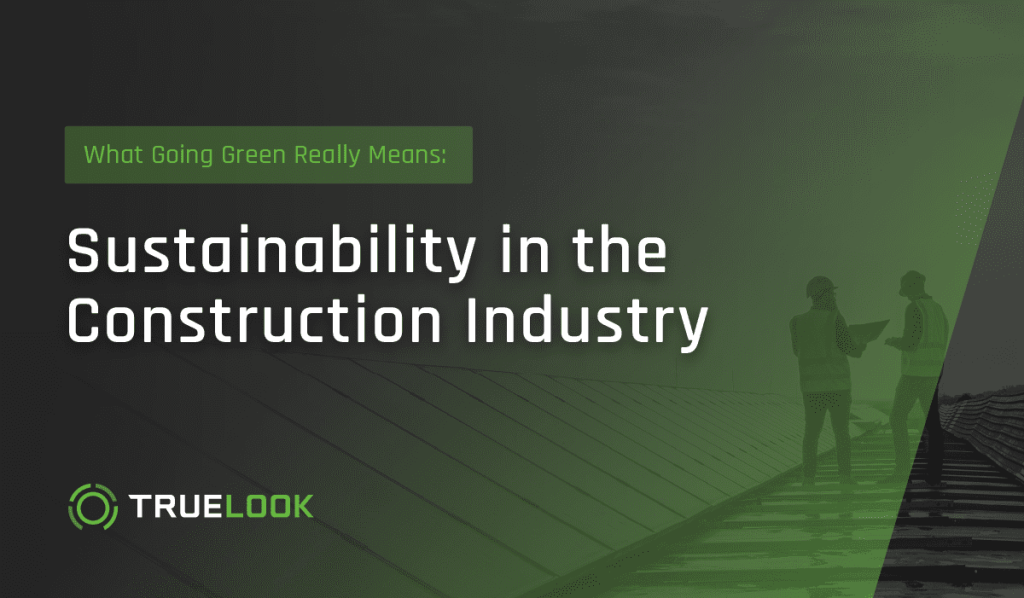
In the past decades, global climate change has been a huge topic in our everyday lives, from large-scale policy discussions, to the micro decisions we make at home and our work. With critical infrastructure being overwhelmed by rising global temperatures and volatile weather and supply chain shortages affecting natural resources, the construction industry is constantly evolving to find best sustainability practices while continuing to produce the best-quality results.
These practices can be seen throughout all aspects of the construction industry, ranging from researchhttps://www.truelook.com/about and development, to practical applications and tools in the field:

As one of the highest users of energy in the world and producing 40% of global carbon dioxide emissions, the construction industry relies heavily on updated sustainability practices to continue building and maintaining the infrastructures that keep everyone going.
For example, Portland cement is the most common building material in the world, but it also produces 2.5 billion tons of carbon dioxide per year, accounting for about 8% of global emissions. With the global construction industry using over four billion tons of cement every year, the need for sustainable concrete has driven leading companies like Amazon to seek sustainable resources for their infrastructure projects. For their second headquarters in Arlington, Virginia, they have partnered with Oregon-based ZGF Architects and Clark Construction to utilize low-carbon building materials like mass timber. The cement change alone is said to have a 15% reduction in their overall carbon footprint.
Mass timber is an engineered wood product that has the potential to reduce global carbon dioxide emissions by 15-20% if used in place of steel. Research has shown that mass timber buildings cut construction time by 25% and require 90% less construction traffic, while checking fire resistance requirements across current codes. In addition to mass timber, there are new innovations in building materials that are continuing the effort to broaden our industry in becoming more sustainable and environmentally safe. Prometheus Materials is now partnering with a European life sciences venture capital firm to produce a new commercial building material that uses micro-algae as a key component. The process to create this new mixture was developed by a team at the University of Colorado Boulder, and combines the microscopic algae with water, sunlight, and carbon dioxide to create a binding agent, not unlike the base substance you find in reefs and oyster shells.

The promising future of building materials shows that there are endless possibilities in pushing for green in the construction industry. In the US, where the industry continues to be a leader in sustainability innovations, firms are focusing on solutions that decrease our carbon footprint, while also creating more efficient work processes for best quality results. A global 2021 survey on different industries found that leaders in engineering and construction have made the most progress toward sustainability in design, with nearly half of respondents pointing to sustainability as a major concern or priority. This focus trickles down to workflow and management, with more than half of engineering and construction survey respondents using mobile technology in design phases, and nearly 40% using mobile maintenance. This pivot for mobile and remote tech collaboration has increased visibility into suppliers, which respondents pointed to as a critical part of their push for sustainability.
In a post-2020 world, remote work is now a standard practice across all industries. By utilizing remote monitoring and collaboration solutions, construction firms are cutting costs and optimizing processes while still keeping tabs on jobsites and ensuring quality results. Construction cameras for field and jobsites are a great example of a simple but effective step in streamlining work and optimizing a firm’s resources. With the ability to cut traveltime, they can reduce firms’ gas usage while increasing visibility through remote monitoring and collaboration tools.

At TrueLook, we provide the cameras and software solutions to connect project managers, field workers, and all other stakeholders with the ease of a tablet, computer, or phone. Our cameras and platform allow team members to connect, monitor, and troubleshoot sites without spending the hours and resources to get on-site.
As we understand the need for constant innovation to reduce carbon footprints, we are also constantly finding creative and dynamic sustainability solutions, such as solar powered cameras and using video documentation to qualify for green building standards.
Our cameras and platform provide a solution for firms to work both efficiently and effectively while reducing their carbon footprint. In a global community where sustainability is a priority, we understand that these decisions are critical. Schedule a free demo today or download our free buyer’s guide to see how we can help you take the next step in your push for green.

